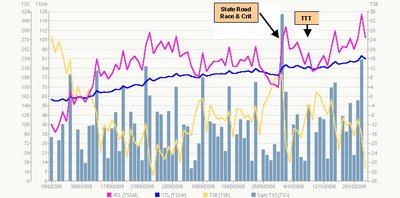The Performance Manager Chart is a tool that's been with us for a while, being first released into the wild by Andy Coggan, and the guys from Training Peaks circa 2006. Before then it was tested by a dozen or so lunatics in a power meter users' asylum known as "TSTWKT".
In the years since, it and its off-shoot variants have become a ubiquitous tool for power meter users to inspect the "forest" that represents our overall training loads, as well as giving additional insight into our training patterns and as a indicator of likely form, either prospectively, or as a retrospective analysis tool.
People use the tool as one guide to their overall training progress, to check their actual and planned workload is appropriate for their current training cycle and training objectives. Of course it's only one part of the picture and as always, one must tend to the individual trees, that is, be concerned with the composition of one's training to ensure the specificity principle of training is not lost in the undergrowth.
There's been plenty written about these issues and the use and sometimes misunderstanding of the use of the tool. I'm not going to delve into the whole shebang here, rather just touch upon one small element about the Performance Manager Chart that the more experienced and/or astute user of this tool will understand.
A quick recap:
The basic Performance Manager Chart plots three things - Acute Training Load (ATL), Chronic Training Load (CTL) and Training Stress Balance, where today's TSB = yesterday's (CTL - ATL). It can also show other information if desired, such as daily training stress scores, best power performances and so on.
In layman's terms, ATL is an indicator of how hard you've been training in recent weeks, and CTL is an indicator of how hard you've been training in recent months. ATL and CTL are both exponentially weighted moving averages of the daily Training Stress Scores (TSS), which in turn are calculated from a rider's power meter data and their current threshold power.
Since ATL and CTL are exponentially weighted moving averages, a key input into their calculation is a time constant. The default time constants used for the PMC are 7-days for ATL and 42-days for CTL.
I thought I'd demonstrate with a video animation what happens if you change these defaults settings and comment on whether and/or why you should or would do so. Cue the (94-second long) video:
Occasionally the question asked is - what time constants should I adopt?
The answers usually include the following points:
- Suggest that you create a range of Performance Manager Charts, each with a different combination of time constants, and see which you consider best reflects your actual performances.
- Note that the chart is not particularly sensitive to changes in the CTL time constant, so you may as well leave that at the default 42-day setting.
- The chart is far more sensitive to changes in the ATL time constant, and some have suggested using a longer time constant for older/masters age riders, and a shorter one for younger riders with faster recovery time, although I'm unsure I would necessarily use such as rule of thumb, as there's more to it than just age.
- Even so, changes to the ATL TC (such that one would still consider it an acute indicator) don't radically change the fundamental patterns displayed on the chart, just the absolute values along with a slight time phase shift in the TSB. Keep in mind that it's the patterns that are more insightful than the absolute numbers.
- If you really want to go there, there is software (RaceDay Apollo) and a method described by Dr Phil Skiba to test yourself regularly such that the "ideal" time constants for you can be calculated, although there is likely a sizeable error range in such calculation of ideal time constants and the effort required to do the frequent regular performance testing to narrow that range is likely beyond the training desire of most.
- If you are a multi-sport athlete, then it gets pretty complicated, as the stress scores from different exercise modalities are not linearly additive, nor will they necessarily use the same time constants.
In my opinion, for vast majority of users there really isn't any need to deviate from the default values, as the additional insight to be gained is likely to be fairly limited. That's not to say it doesn't exist but keep in mind that some won't have TSS data for all rides, and/or TSS values that are possibly subject to errors from an incorrect estimation of threshold power (let alone the chosen source of power data).
But by all means this is not meant to dissuade you from playing with the options. Go forth and explore. Or let coach worry about it. We're good at that.
If you want to read more on the Performance Manager, I suggest the following links as starting points:
My Performance Manager Chart by me
Season Review with a Performance Manager Chart by me again
What is the Performance Manager Chart by Hunter Allen
The scientific inspiration for the Performance Manager by Dr Andrew Coggan
Read More......




























